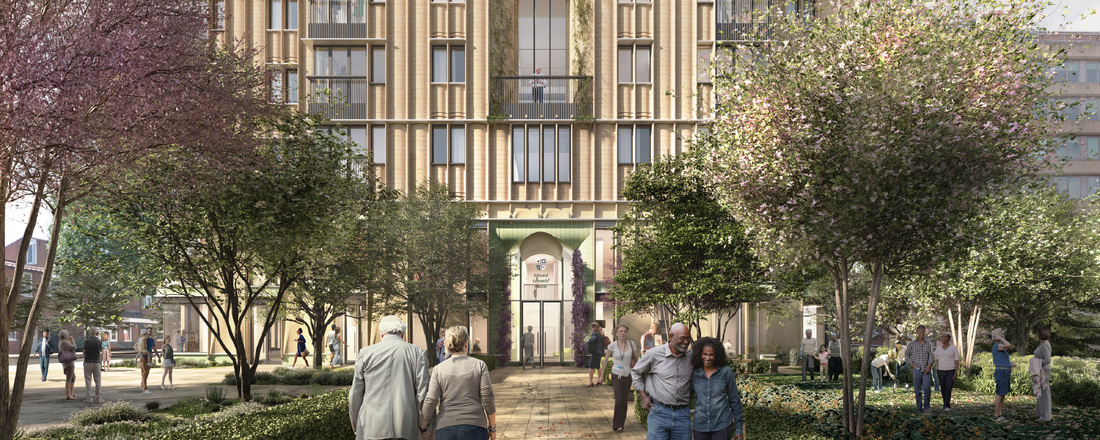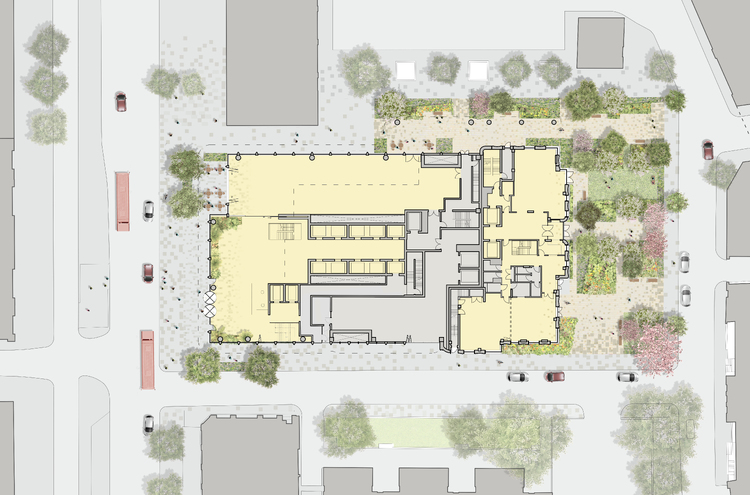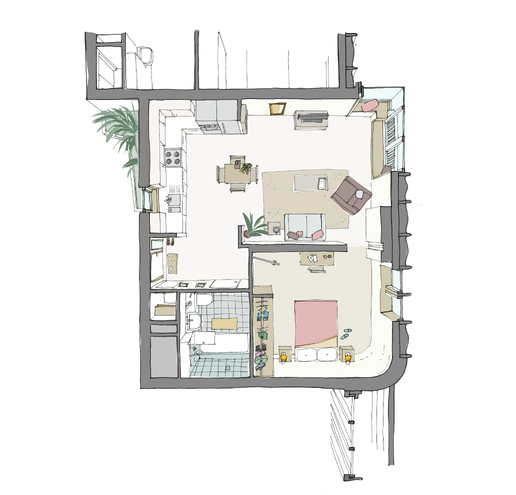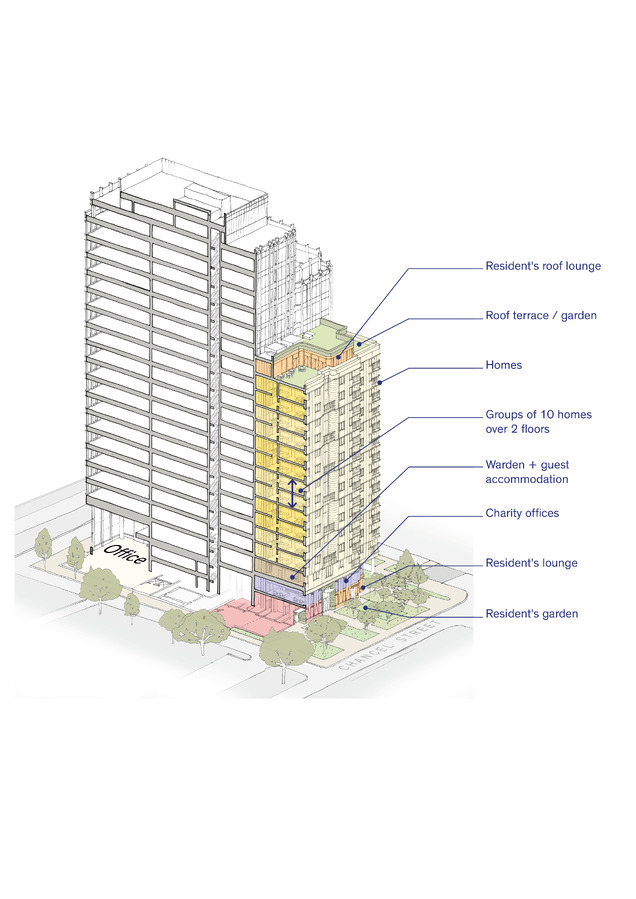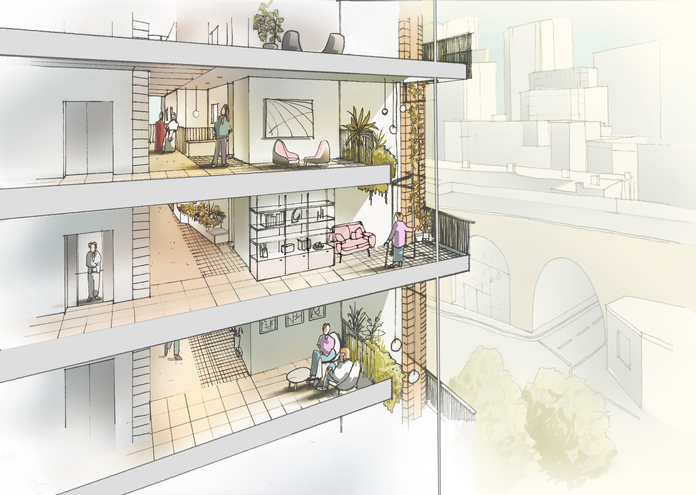Get updates from The Developer straight to your inbox Yes, please!
A new almshouse for London: “We’ve never had pushback on stacking them up”
Could a new almshouse in Blackfriars be a future model for independent, affordable living for older Londoners? Chris Wilson, CEO of Southwark Charities and Justin Nicholls, founding director of Fathom Architects share their vision

Psychologist B. F. Skinner famously compared old age to a foreign country: “You will enjoy it more if you have prepared yourself before you go.” But are UK towns and cities ready to welcome those on the journey?
Figures from the 2021 census revealed that there are 2.5m people aged 50 or older living in London, while the OECD estimates that older adults comprise 15% of the population of metropolitan areas of the UK. The OECD report calls for infrastructure and urban forms to be redesigned to consider walking, affordable housing and social participation as effective measures of preventative care.
A new model for independent city-centre living will be embodied by a new almshouse in Blackfriars, according to Chris Wilson, CEO of Southwark Charities and Justin Nicholls, founding director of Fathom Architects, in conversation for The Developer Podcast. The future 15-storey contemporary almshouse includes 62 homes, 100% affordable, for local elderly residents, in addition to 22,500sqm of workspace, a community space that can be booked by anyone and public gardens.
“What’s really interesting about this project is that it’s creating a community hub around older people in London, and that’s really important as the population ages,” says Nicholls. “We need to change the mindset and recognise that [older] people can make a positive contribution to the city.”
Southwark Charities have been providing almshouses in the borough since 1753; they have 65 homes in the borough, while also providing grants to support community organisations or charities working with Southwark residents aged 55 plus. Their almshouses provide affordable flats for older people in need, hardship or distress who are living independently without the need of on-site care. The Weekly Maintenance Charge paid by residents is £30 per week; residents pay council tax (unless exempt), plus electricity and gas utility bills.
The tower on Nicholson Street replaces an almshouse that dates from the 1970s. The red-brick complex of 23 flats will be demolished with all residents will move out during the rebuild to a United St Saviour’s Charity almshouse, also in Southwark. The development of the new building will more than double the existing number of homes and provide a new funding stream through revenue from the flexible workspace.
“I’ve been trying to find a plan that rebuilds the almshouses and provide a means of funding through an office building to boost long-term income,“ Wilson says. “We don’t have heritage almshouses with listings, so we are able to contemplate knocking them down and rebuilding them.”
“Our founder didn’t leave us a whole pot of money to build a single coherent estate. He left us property, and we had to save up the rent… to build another block,” Wilson explains.
Wilson emphasises that many residents have come from high-rise council blocks and would not feel safe in a ground-floor flat. “We’ve never had pushback on stacking them up”
The demolition of any existing structure and the carbon cost of new construction is not ideal in a climate emergency. In response to the question of demolition, Nicholls says: “The existing building performs poorly for the charity. Current flats have been created by combining the original studios creating awkward layouts with small kitchens, access is difficulty with multiple level changes and the thermal performance is poor. Redevelopment allows the creation of an exemplar standard of accommodation and increases homes from 25 to 62. The intensification of the site will also generate funds to provide further almshouses in Southwark.”
The new block will be insulated to Passivhaus standard with a heat recovery system for hot water and fitted with air source heat pumps, with the intention to make it free of all fossil fuel connections.
Vertical communities have historically been stigmatised or cast as antisocial by the architectural and mainstream UK press. But Wilson emphasises that many residents have come from high-rise council blocks and would not feel safe in a ground-floor flat. “We’ve never had pushback on stacking them up,” says Wilson. “The question is how to do that without creating an anonymous block of apartments. How do you foster an encounter; a community.”
“Like all people, [residents] don’t get on with everybody. Some of them sit in the garden, some stay in their flat all day, some go out all day….” Wilson says. “You can talk about community, but you can’t force people to take part in it…. You create spaces where people are likely to encounter somebody, and hopefully because it’s not like they’ve got an appointment to get to, they can chat.”
A tower is a significant departure in architectural form from the traditional one-storey almshouse. Yet Fathom’s expression in the architectural imagery appears no less elegant, with its pale curved terracotta façade and arched entranceway.
Inside the building, to create a feeling of neighbourliness, Fathom has grouped the flats in clusters of 10 homes over 2 floors with shared facilities such as lounges.
“We designed it so that you can look into some of the shared spaces and if there’s somebody you don’t want to spend time with, you can keep on walking – you’re not getting stuck,” Nicholls adds.
Making visitors to the almshouse feel comfortable is also important to stave off loneliness – families want to come and see their elderly relatives, but will reduce the frequency or length of visits if the experience is unpleasant or impractical. “Children being bored is one of the leading reasons why people leave early when visiting their parents,” Nicholls says, stressing the importance of pleasing, functional social spaces, and space to play – lounges and gardens – which make it easier for the whole family to visit.
Although the almshouse is not a care home, the creation of supportive environment has led to the inclusion of features that provide “pastoral care”. This includes a ground-floor “porter’s lodge” – a reception area that will feature an "awake person 365 days a year, and 24 hours a day, accepting packages, offering security and being there to pick up Tesco shopping” or should an ambulance need to be called.
Both Nicholls and Wilson underline the importance of words, electing to use the term “porter’s lodge” – inspired by Oxford colleges – over words like “security” or “concierge” to connote domesticity and caretaking.
“We talked a lot about what kind of environment the almshouse could be,” says Wilson. “In the olden days we used to employ ‘wardens’, and latterly we called them ‘scheme managers’.
“‘Housekeeper’ is another good expression, so we’ve put in a housekeeper’s flat. It could be a couple, where one person is the housekeeper and the other person is a maintenance operative who can change a tap washer or a lightbulb, that would be a great combination if we could find it.”
“Children being bored is one of the leading reasons why people leave visiting their parents”
The housekeeper is “someone to provide pastoral care and have an oversight of the people who might be in this transition phase… whose faculties are starting to go,” says Wilson. Three guest suites are also provided which could be used for a temporary on-site carer.
“We support people to live independently, but inevitably… the machine parts of the body start to break down or mental acuity starts to fail,” explains Wilson. With the strain on social care, “it can take a lot longer for someone to transfer from our situation into a carer situation.”
As for the design of the flats, Nicholls notes that older people spend more time on average in their homes than others. “The quality of the space that you’re providing is much more important,” he says – one reason the apartments are “slightly oversized compared to a traditional one-bed.”
Nicholls says the corner views are intended to help with loneliness. “Being able to look down and watch people moving to and fro makes a big difference.” There’s also a window from the kitchen into the corridor. A sliding screen to the bedroom allows those convalescing in bed to enjoy the view to the corner window.
“I love old almshouses,” says Wilson. “They are beautiful buildings, but a lot of them came out of a very paternalistic view, and they were designed as very insular and inward-looking communities.
“Retirement from the world? I don’t think older people want that,” Wilson adds. “I’m a pensioner too, but I’m not looking to turn inwards and away from the world. I still want to be engaged.”
Subscribe to The Developer Podcast wherever you get your podcasts, and sign up to The Developer Weekly email to find out when new episodes go live. You can support our podcast on Patreon at www.patreon.com/thedeveloperuk
If you love what we do, support us
Ask your organisation to become a member, buy tickets to our events or support us on Patreon
Sign up to our newsletter
Get updates from The Developer straight to your inbox
Thanks to our organisation members
© Festival of Place - Tweak Ltd., 124 City Road, London, EC1V 2NX. Tel: 020 3326 7238
